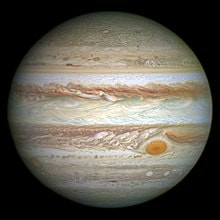 This piece was originally broadcast on Radio Scilly in April 2019. During April, Jupiter, the largest planet in our solar system, is increasing in brightness and visibility. It’s been absent from our skies for months, along with lovely ringed planet Saturn. At the moment, Jupiter’s a dominant object in the wee hours of the morning, albeit one that doesn’t get very high in the sky. However on Scilly, our long and low horizons give us a good chance of seeing. By the end of the month Jupiter will be rising in the sky from midnight. However for now, you’ll have to be up just before dawn to catch a good glimpse of this bright gas giant. Currently, the planet reaches its peak height (also known as its culmination) somewhere around 4am. Is it worth getting out of bed for? If – like me – you’ve missed this gem of a planet then of course the answer is yes. And the bonus is that at the moment it’s best viewed with binoculars or a small telescope. However the truth is that Jupiter will be visible far better as summer gets into swing and it rises in the sky. Rather earlier at that. By July, it’ll be visible at dusk! Jupiter is the 4th brightest object in the night sky, after the Moon, Venus and then Mars. Jupiter is known as the largest planet in the solar system, and by quite some stretch. Jupiter’s mass is 318 times that of the Earth, and in fact Jupiter is 2.5 times more massive than all of the other planets in the solar system combined! It’s a gas giant, mostly composed of Hydrogen with some Helium, though it likely has a rocky core. To look at, it’s stripey – as it has a distinctive system of bands of clouds, made from ammonia crystals, looping round its middle. With binoculars, you’ll be able to see Jupiter as a flat disc, this shape caused by its incredibly fast spin rate for such a whopping object – a day on Jupiter is just 10 hours short. With a small telescope, you’ll be able to pick our Jupiter’s distinctive clouds and possibly – depending on timing and visibility which always requires a bit of luck – the great red spot. This is a giant tornado-like storm that’s been raging on Jupiter for at least 350 years. With winds at an estimated 270mph, it really is blowing a hoolie. Jupiter can be found, low in the sky, early in the morning, by looking to the South!
0 Comments
This article originally appeared in Scilly Now & Then magazine's April/May edition.
Now the clocks have gone back as we are in the midst of a lovely Scilly spring, the downside does mean later nights for us stargazers, and, potentially, the start of bleary-eyed mornings. That aside, there’s still much to enjoy up there. The Spring constellations are slowly working their way into peak position in the night sky. We’re fast losing Orion; Taurus is hot on its heels, if at all visible, and the twin stick-figures of Gemini are low in the sky. Between the much fainter constellations of Cancer and Virgo you will now spot Leo, the lion. If these names sound familiar it’s probably because you’ve read about them in the back of a magazine in your horoscope, and yes, they are constellations of the Zodiac. But I’m not talking about your ‘star signs’. Astrology – unlike astronomy – is not a science, although to be fair, they both involve the stars. That’s where it ends. Astronomy can explain the position of the stars in the sky, but frankly, it’s up to you to interpret their meaning. In astronomy, the Zodiac refers to the twelve constellations that our Sun passes through, identified back in the day by the ancient Babylonians. This area of sky also includes the apparent paths of the moon and the planets. We also call this imaginary line frequented by Moon, Sun and planets ‘the ecliptic’. Arcing at 25.5 degrees, East to West, locate this area of the sky and you will also find some of the most wonderful night sights. Leo is one of the oldest recognised constellations in the night sky, documented even by the Mesopotamians, and known as the lion in many ancient cultures. Handily, it’s one of the few constellations that looks like its namesake. You can find the Lion’s head south of the ‘dipper’ in the Plough, where it appears as a backwards question mark. The bottom of this sickle is Regulus, Leo’s brightest star, noted for its fast bullet-like shape and peculiar motion. Back on Earth, our observatory is now open for the season on St Martins. For 2019 our regular openings – come rain or shine – will be Tuesday evenings and Friday afternoons, for a look around and fingers crossed some star (or sun) gazing. We’ll open other nights, which will vary week to week depending on cloud and astronomical events. We look forward to welcoming you – finally – to Scilly’s own observatory! |
BYCharlie Payne POSTS
September 2024
|

 RSS Feed
RSS Feed